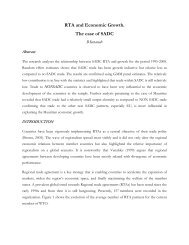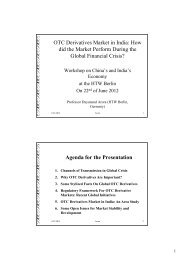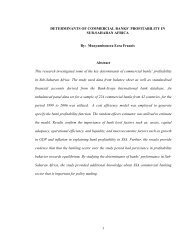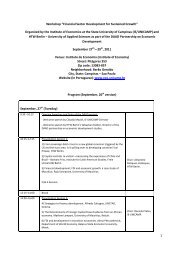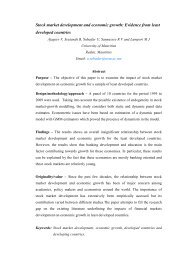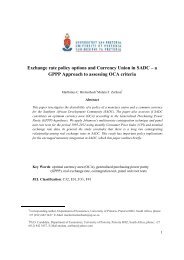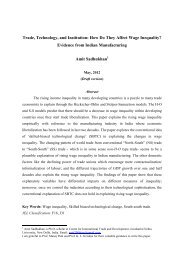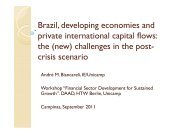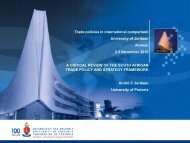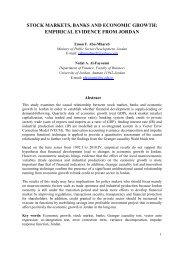On the Determinants of Foreign Capital Flows - DAAD partnership ...
On the Determinants of Foreign Capital Flows - DAAD partnership ...
On the Determinants of Foreign Capital Flows - DAAD partnership ...
Create successful ePaper yourself
Turn your PDF publications into a flip-book with our unique Google optimized e-Paper software.
• A good exchange rate policy among various o<strong>the</strong>r governmental policies does foster<br />
investment inflows. In a country where <strong>the</strong> currency is appreciating, positive relationship<br />
with FDI is expected and vice-versa 5 . Dunning (1977) held that in <strong>the</strong> 1960’s, <strong>the</strong> increase<br />
in <strong>of</strong>fshore investment was due to <strong>the</strong> shortage <strong>of</strong> dollars internationally. Singh in 1983<br />
explored a fur<strong>the</strong>r aspect <strong>of</strong> exchange rate on FDI issues where he linked <strong>the</strong> fact that<br />
exchange rate influences value <strong>of</strong> repatriated pr<strong>of</strong>its. Blonigen (1997) presents ano<strong>the</strong>r way<br />
in which fluctuations in <strong>the</strong> exchange rate level may affect inward FDI for a host country in<br />
terms <strong>of</strong> prices <strong>of</strong> assets especially for asset-seeking investment. O<strong>the</strong>r empirical studies<br />
confirmed this strong impact <strong>of</strong> exchange rate on FDI. Yoshimura and Kiyota (2003)<br />
studied <strong>the</strong> impacts <strong>of</strong> exchange rate on Japan’s FDI for different periods and <strong>the</strong>ir work<br />
exposed that such appreciation <strong>of</strong> <strong>the</strong> home currency vis-à-vis <strong>the</strong> host currency encouraged<br />
FDI from <strong>the</strong> home country to <strong>the</strong> host country. Moreover, an important point when<br />
considering exchange rates and FDI is to acknowledge <strong>the</strong> fact that <strong>the</strong>y may have a bidirectional<br />
relationship- In countries with fixed or quasi fixed regimes, this is said to be true<br />
while for large freely floating economies, causality is said to flow from exchange rate to FDI<br />
(Liargovas and Kosteletou 2000).<br />
• Domestic Investment measured in <strong>the</strong> form <strong>of</strong> <strong>the</strong> aggregation <strong>of</strong> private/public<br />
investment and FDI is said to have a two-way relationship. Domestic firms, mainly private<br />
ones respond to FDI inflows by increasing <strong>the</strong>ir investment to face competition from <strong>the</strong><br />
foreign counterparts (De Mello, 1996). As public investment is usually used as a proxy for<br />
physical and human infrastructure, it suggests that <strong>the</strong> better <strong>the</strong> infrastructure, <strong>the</strong> more<br />
pr<strong>of</strong>itable would be <strong>the</strong> FDI and its beneficial effects. Coughlin et al (1991) reached <strong>the</strong><br />
conclusion that more extensive transportation infrastructures were associated with increased FDI<br />
through <strong>the</strong>ir study. Harrison and Revenga (1995) clearly include domestic investment as<br />
an explanatory variable <strong>of</strong> FDI but <strong>the</strong>y find that compared with <strong>the</strong> size <strong>of</strong> <strong>the</strong> local market<br />
and openness to trade, domestic investment has no impact on FDI. As for causality,<br />
5 New Economist: FDI flows, Is China crowding out <strong>the</strong> rest <strong>of</strong> Asia?<br />
10



